SCROLL DOWN
|||||||||||||||||||
VVVVVVV
RESEARCH PROJECT ON
KING MINOS - MINOTAUR
- THESEUS
DAEDALUS and ICARUS
for
Ms. Laura Cherry
by
Liron, Sifron and
Samuel Benjamin
------- START --------
KING MINOS
A short history
A legendary ruler of Crete; he was the son of Zeus, the king of the gods, and Europa, a personification of the continent of Europe. Minos obtained the Cretan throne by the aid of the Greek god poseidon,and from Knossos (or Gortyn) he gained control over the Aegean islands, colonizing many of them and ridding the sea of pirates. He married Pasiphae, the daughter of the Sun (note those solar neutrinos !), who bore him, among others , Androgeos, Ariadne, and Phaedra, and who was also the mother of the Minotaur.
Minos successfully warred against Athens and Megara to obtain redress after his son Androgeos, was killed by the Athenians. In Athenian drama and legend Minos became the tyrannical exactor of the tribute of children to feed the Minotaur. Minos was killed in Sicily by the daughters of King Cocalus, who poured boiling water over him (ouuuuch!) as he was taking a bath. After his death he became a jugdge in Hades.
Although Athens preserved a hostile
tradition, the general account shows Minos as a POWERFUL, JUST RULER,
very closely associated with religion and ritual. In light of
excavations in Crete, many scholars consider that Minos was a royal or
dynastic titles for the priestly rulers of Bronze age, or Minoan,
Knossos.
-------------------------------------------------------
The legendary king of Crete, son of Zeus and the Phoenician princess Europa. Minos and his two brothers, Rhadamanthys and Sarpedon, were raised in the royal palace of Cnossus. Minos married Pasiphae, daughter of the sun-god Helios. Some of their children were Phaedra, Ariadne, and Andregeos.
In mythology, a dispute over the
sovereignty of Crete led Minos to ask Poseidon for help. He asked the
god to send an offering as a sign of his true kingship. The god of the
sea sent a gleaming pure white bull, which emerged miraculously from
the waves. This confirmed to all concerned that Minos was their true
king. However, as soon as King Minos saw this magnificent beast he
refused to sacrifice it to Poseidon, and replaced it with another.
Poseidon in retaliation sent Pasiphae into uncontrollable lust for this
huge beast. So much so that she had the urge to mate with this huge
animal. To do this she requested the help of Daedalus, a craftsman and
inventor, who built a hollow wooden cow. Pasiphae hid inside, the
amorous bull mounted the wooden cow and as a result Pasiphae conceived
its child, or rather a creature which was half man and half bull, which
became known as the Minotaur (Minotauros, "the bull of Minos").
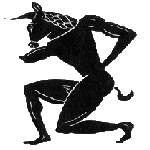
King Minos ordered Daedalus to construct a palace to hide the Minotaur, and Daedalus built Labyrinth. Because of his meddling Minos imprisoned Daedalus and his son Icarus inside a tower. They escaped by making wings from wax and feathers, but Icarus was killed when he flew to close to the sun.
When Androgeos, the son of King Minos, attended the games in Athens he was victorious in all events, but was murdered through envy by other contestants. Minos then attacked Athens to avenge the death of Androgeos, and, after gaining control of the city he granted Athens peace, but with one condition: that every nine years Athens should send seven of their finest young men and young maidens to Crete, as sacrifice to the Minotaur. When the hero Theseus heard about this practice, he volunteered to be one of the victims, killing the Minotaur, and freeing Athens from this grizzly duty.
Another legend of which King Minos is part, is that of King Nisus of Megara, who to protect his city had to keep a lock of red hair hidden in his own white hair. King Minos besieged Megara, but Nisus knew that all would be well, as long as the lock of red hair was still in place. However, Scylla the daughter of Nisus fell in love with Minos, and to prove her love for him she cut the lock of red hair from her fathers head, which killed Nisus, and Magara fell. When Minos found out that Scylla had been responsible for her father's death he killed her. She was reincarnated as a seabird, to be pursued by her father Nisus, who had been turned into a sea eagle.
Sir Arthur Evans a British archaeologist
gave the name "Minoan" to the Cretan civilization, from King Minos'
name, (A.D. 1900). Even the name Minos, may not have been the king's
real name (and is not Greek in origin) and could have been a hereditary
title of Minoan rulers.
-------------------------------------------------------------------
Minos was a semi-legendary king of Crete and son of Zeus and Europa. By his wife, Pasiphae, he was the father of Ariadne, Deucalion, Phaedra and others. He reigned over Crete and the islands of the Aegean three generations before the Trojan War. He lived at Cnossus for periods of nine years, at the end of which he retired into a sacred cave, where he received instruction from Zeus in the legislation which he gave to the island. He was the author of the Cretan constitution and the founder of its naval supremacy.
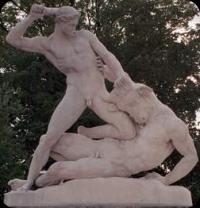
In Attic tradition and on the Athenian stage Minos is a cruel tyrant, the heartless exactor of the tribute of Athenian youths to feed the Minotaur. It seems possible that tribute children were actually exacted to take part in the gruesome shows of the Minoan bull-rings. To reconcile the contradictory aspects of his character, two kings of the name of Minos were assumed by later poets and mythologists.
Since Phoenician intercourse was in later times supposed to have played an important part in the development of Crete, Minos is sometimes called a Phoenician. There is no doubt that there is a considerable historical element in the legend; discoveries in Crete prove the existence of a civilization such as the legends imply, and render it probable that not only Athens, but Mycenae itself, was once subject to the kings of Cnossus, of whom Minos was greatest.
Minos himself is said to have died at Camicus in Sicily, whither he had gone in pursuit of Daedalus, who had given Ariadne the clue by which she guided Theseus through the labyrinth. He was killed by the daughter of Cocalus, king of Agrigentum, who poured boiling water over him in the bath . Subsequently his remains were sent back to the Cretans, who placed them in a sarcophagus, on which was inscribed: "The tomb of Minos, the son of Zeus."
The earlier legend portrays
Minos as a beneficent ruler, legislator, and suppressor of piracy. His
constitution was said to have formed the basis of that of Lycurgus. In
accordance with this, after his death he became judge of the shades in
the
underworld; later he was associated with Aeacus and
Rhadamanthus.
---------------------------------
 King
Minos of Crete asked the god Poseidon for a magnificent bull with which
he could demonstrate his wealth and power. Poseidon agreed to the
request on one condition and that was, at his command, the bull would
be sacrificed to him. King Minos agreed, however when the time came for
the sacrifice King Minos could not bear to kill the bull. He
substituted another bull in place of the devinely created one.
King
Minos of Crete asked the god Poseidon for a magnificent bull with which
he could demonstrate his wealth and power. Poseidon agreed to the
request on one condition and that was, at his command, the bull would
be sacrificed to him. King Minos agreed, however when the time came for
the sacrifice King Minos could not bear to kill the bull. He
substituted another bull in place of the devinely created one.
Needless to say, Poseidon was not at all happy and as a revenge caused King Minos' wife Pasiphae to fall in love with the bull. Following a bit of quite unnatural hanky panky she gave birth to Minotaur who was half bull half man. At its birth it was foretold that the Minotaur would never be killed by club, knife, spear or sword.
The king was not unduely impressed with his wifes production and had Daedalus build a Labyrinth to house the minotaur. The idea being that the Minotaur would not be able to find his way out. Periodically King Minos would require of Athens 7 boys and 7 girls to be sacrificed to the Minotaur.
On one such occasion they were accompanied by Theseus. King Minos' daughter Ariadne fell in love with Theseus and gave him a ball of thread, the end of which he tied to an olive tree before entering the labyrinth. He found and slayed the Minotaur. Then, by using the trail of string he had laid, found his way out again.
King Minos was convinced Daedalus had
committed the crime because,
he reasoned, that he was the only one who could find his way out again
so he imprisoned Daedalus and his son Icarus in the labyrinth. Daedalus
made wings of wax to allow his son and himself to fly out but his son
flew too close to the sun, his wings melted and he fell into the sea.
--------------------------------------------------
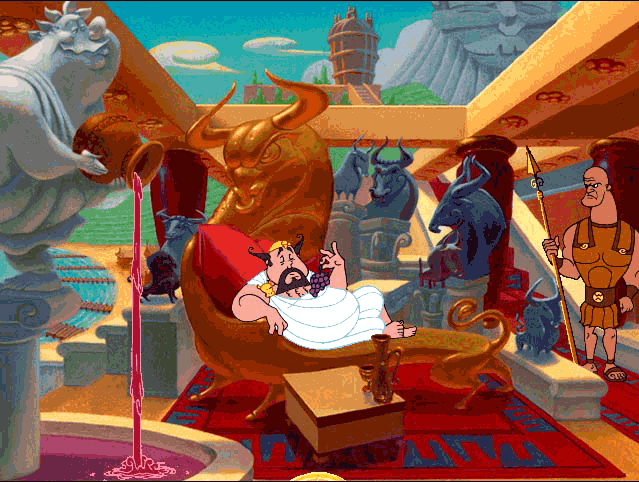
Other greek pictures : www.disneyhercs.com/
ah/studioart.html
----------------------------------------------------------------------------------------------








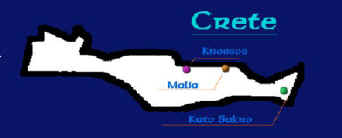 The Birth Place of Greece...
The Birth Place of Greece...On the eve of the year 1900, Sir Authur Evans, discovered the Minoan Palace Knossos and what was to become the Minoan civilization. Settled upon the isle of Crete, and named after the mythical Cretan King Minos, Evans not only discovered an influential civilization with extensive trade routes covering such vast territories as Turkey, Cyprus, Egypt, Afghanistan,and Scandinavia, but the birthplace of ancient Greece as well.
|
|
|
(The Palace of Knossos) |
The palace of Knossos and the Minoan Civilization thrived in the Bronze age (in roughly 3,000 BC) within the Aegean. The product of early Phoenician settlement upon Crete, the Minoans hosted three great palaces known as Knossos, Kato Sakro (also known as Phaestos), and Mallia. Of the three great palaces, none surpasses the exquisite palace of Knossos.
|
|
| (Large pots such as these found at Knossos, were part of a large storeroom. Evans measured the capacity of each, and found in total the storeroom could hold roughly 19,000 gallons of material.) |
The palace of Knossos was a multi-storied building, spanning five and a half acres of land, and housed not only the King of the Minoan State, but also his advisors, his trade goods, and several craftspeople. In addition, the palace held within its walls a central court yard, numerous rooms and corridors, a throne room, large baths, a large courtyard, enormous storerooms, some craft workshops, the administrative chambers, and an intricate plumbing system. The palace itself, however, was not indestructible to the ravages of time or change. Renovated, one renovation atop of the other, the palace changed as the administrative center of Minoan civilization grew, but, it was always built according to a plan. Outside of the palace of Knossos were many houses, a smaller palace, and some craft workshops. Important to the status and power of the Minoan state were the palace's trade routes, via the extensive stream systems of Crete, the intricate roads, and most importantly the naval strength of the Minoan civilization itself. Where the Egyptians feared the treacherous seas of the Aegean and Mediterranean, the Minoans dwelt in power, so much so that the city of Knossos did not build city walls for protection. The trade routes from Knossos established communications and goods from such diverse areas as Turkey, Cyprus, Egypt, Afghanistan, and Scandinavia. Goods traded with Knossos were copper, ivory, amethyst, lapis-lazuli, carnelian, gold, amber, and other important commodities.
 |
|
(Fresco of three Minoan Women.) |
The palace of Knossos was only destroyed twice in it�s history, once from fire (roughly in 1700 BC) and a wall collapse, the second and later destruction from a major earthquake which ravaged Crete. The later earthquake not only brought destruction to both Knossos, but to Kato Sakro and Mallia as well. These events, however, were not to end Minoan civilization. Not until 1450 BC was the end of Minoan Civilization realized. The final collapse of the Minoan state remains a half-solved mystery. Two factors are thought to have contributed to the end of the Minoan: the possible eruption of the volcano Thera and the rise of the Mycenean civilization upon Crete.
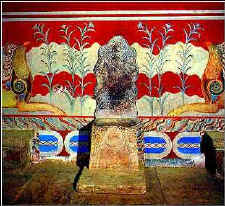 |
|
(The Throne of King Minos) |
Greek mythology immortalized Crete and Knossos with its legends. According to the Greeks, Mount Ida which is on Crete was the location where Rhea, the Earth Mother, gave birth to Zeus. He was fed by nature a diet of honey and goat�s milk, was tended by a group of nymphs, and was guarded by an army of youths against his father, Cronis, whose reign was threatened by Zeus� existence. Zeus fathered a son, Minos, who became the King of Knossos, Crete, and the rest of the Aegean.
King Minos' son, Androgeus, according to the myth, was a strong, athletic youth. He was sent to represent Crete in the Athenian games and was successful in winning many events. The King of Athens murdered Androgeus out of jealousy. When Minos heard about the death of his son, he was enraged and deployed the mighty Cretan fleet. The fleet took Athens and, instead of destroying the city, Minos decreed that every nine years Athens was obligated to send seven young men and seven virgin women. King Minos threw them into a labyrinth where they were sacrificed to the Minotaur. Theseus, the Athenian King�s son, volunteered to be one of the seven sacrificial young men with the intention of killing the Minotaur and ending the suffering of Athens. If he succeeded in his mission, he told his father that he would raise white sails instead of the black sails on his ship. Theseus arrived at the palace of the Cretan King, and with the help of Minos� daughter, Ariadne, who fell in love with Theseus, he was able to kill the Minotaur. In returning home, Theseus, in his excitement, forgot to change the sails on the ship from black to white. The King of Athens saw the black sails. Thinking that his son�s plan failed and that Theseus was dead, the king flung himself into the sea and died.
|
|
| (Minoan Prince) |
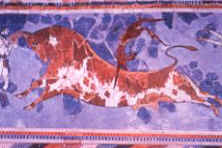 |
| (Bull Leaping Fresco) |
What remains of Minoan culture, is a half understood mystery. The language of the Minoans, known as 'Linear A', has never been deciphered. The lack of a decipherable language has made attempts at a definite description of Minoan life and culture nearly impossible. However, what archeologists have learned about Minoan life comes from the exceptional art, architecture, and tool artifacts of the Minoans.
Minoan life was ruled by a King and nobles who governed all aspects of Minoan life, including trade, art, and religion. The government of the Minoan was theocratic, and the religion of Minoan was matriarchal and centered around the worship of several goddess and high priestesses. Accordingly the Minoans took part in many ritual acts, including "bull leaping". Bull leaping involved mid-air leaping, onto the back of a charging bull.
Stratification in Minoan Culture consisted mostly between Nobel, Citizen, and Slave. However, the stratification of the Minoan appears to have been minimal. Slaves were said to have been treated fairly by their masters and in the religious spectrum the only act slaves could not partake in was bull leaping. Additionally, there were no acts which were restricted from women (that we know of). As seen on many of the beautiful fresco's often times the women worked along side the men. Similarly, archeologists surmise that due to a lack of elaborate burials, (like those seen in Ancient Egypt) the king and nobles were not kept in the highly structured position often kept by state civilizations of its type.
Some of the buildings are scrupulously and faithfully restored and the archaeological site as a whole conveys an overwhelming impression of the ancient Minoan culture around 1500 BC. It is ever again fascinating to face the great feats, which were created thousands of years ago!
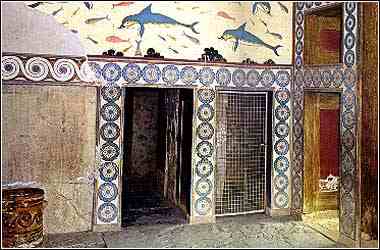
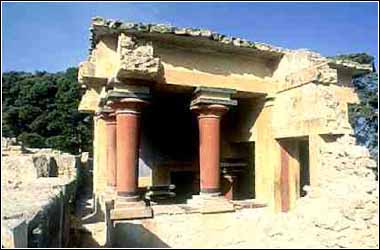
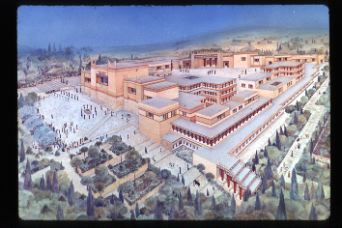
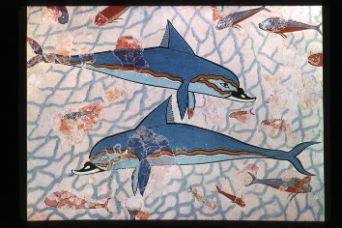



 |
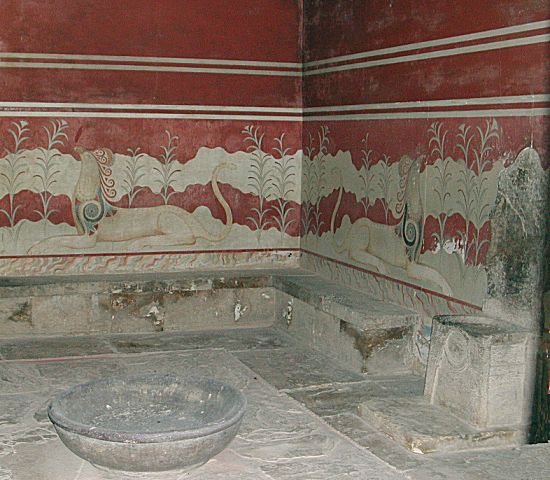 |
 |

Palace of King
Minos
fresco "Lily Prince"
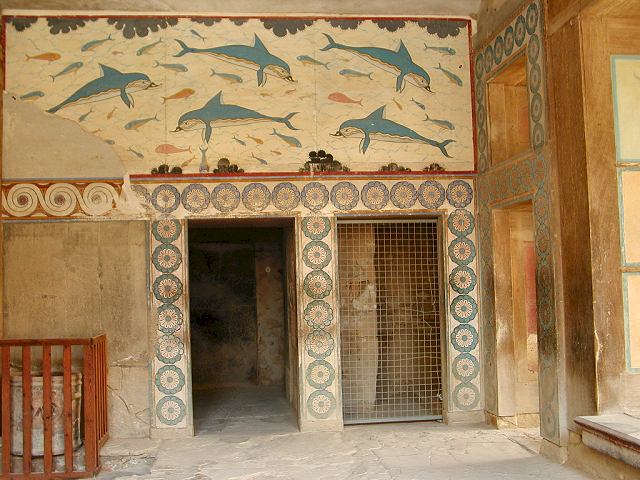
 |
At the Court of King Minos |
MINOAN CIVILIZATION
 |
 |
| AERIAL OF PALACE OF KING MINOS AT KNOSSOS | PORCH OF PALACE OF KING MINOS AT KNOSSOS |
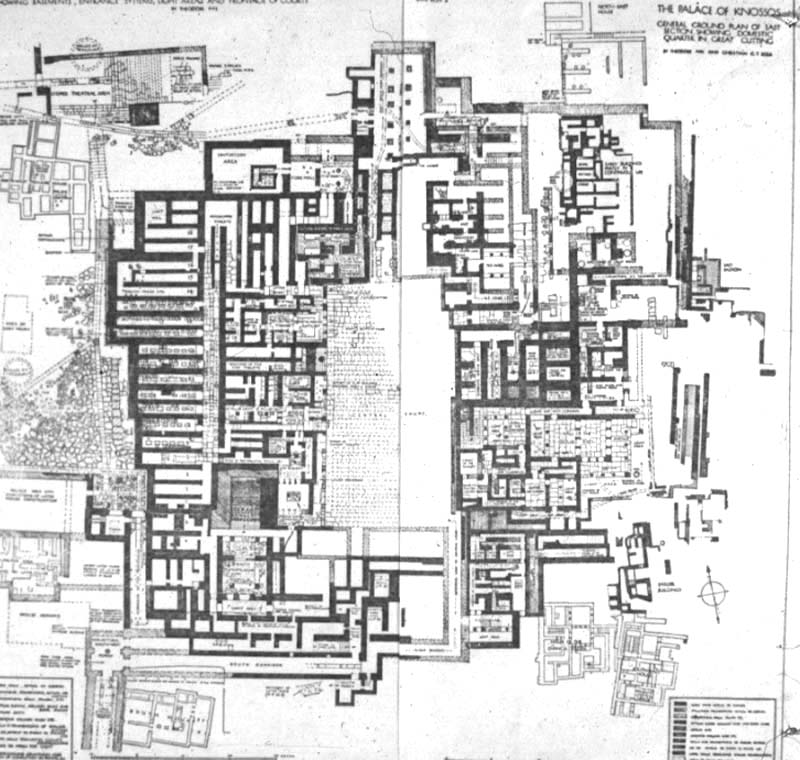 |
 |
| PLAN OF PALACE OF KING MINOS AT KNOSSOS | RESTORED PORCH OF PALACE OF KING MINOS AT KNOSSOS |
--------------------------------------------------------------------
Flying is probably mankind’s greatest dream, it is a deep-rooted topic in ancient literature and still fascinates us today. Daedalus was the son of Metion who was a descendant of the craftsman God Hephaestos. He lived in Athens with his wife Nausicrates and his son Icarus. His reputation was great and King Minos of Crete (Island of the South Aegean sea), invited him to build a palace in the city of Knossos, where he could hide his treasures from his enemies. Daedalus succeeded in building a complicated complex of rooms and corridors, the Labyrinth. So if an enemy entered the Labyrinth they would not be able to find their way out. For additional security the Minotaur, who was half man and half bull, was allowed to live in there.
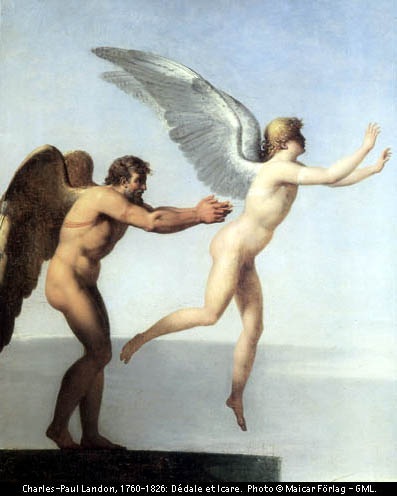 King
Minos was grateful to Daedalus but he could not let him go from the
island, being afraid that he will tell the secret to the Athenians. The
secret was that somebody had to pull with him a sewing thread, before
entering the Labyrinth, so he could find his way out. Deadalus told the
secret to King Minos’ daughter named Ariadni. She fell in love with
Thesseus, who was the son of King Aegean of Athens and told him the
secret as well. Theseus entered into Labyrinth and killed the Minotaur
who was eating seven virgin Athenians girls per year, an offering from
King Minos as a peace gift.
King
Minos was grateful to Daedalus but he could not let him go from the
island, being afraid that he will tell the secret to the Athenians. The
secret was that somebody had to pull with him a sewing thread, before
entering the Labyrinth, so he could find his way out. Deadalus told the
secret to King Minos’ daughter named Ariadni. She fell in love with
Thesseus, who was the son of King Aegean of Athens and told him the
secret as well. Theseus entered into Labyrinth and killed the Minotaur
who was eating seven virgin Athenians girls per year, an offering from
King Minos as a peace gift.
Deadalus had a solution for this difficult situation, using his talents
he built wings glued with wax for him and Icarus. King Minos believed
that Daedalus betrayed him and the two pioneer pilots escaped by air.
Icarus flew too near the sun and after his wings melted, dropped into
the sea near an island, that is called today Ikaria. Deadalus arrived
safe in Athens and then travelled a lot, running away from the king. He
built a temple to Apollo at the city of Kyme and dedicated his wings to
God. He finally went to Sicily at the services of King Cocallus. Icarus
was worshiped as a hero for his sacrifice.
Freud described dreams about flying as ‘typical’ because they occur in
large numbers of people with very similar content, Freud did not dream
of flying himself. It could be argued that dreaming of flying is a
natural progression as we grow. First we crawl, then we toddle, walk
and then run; it would be natural for a child’s mind to expect to fly
next. Flying in dream is vary rarely unpleasant, usually when the
dreamer lands it is with a gentle floating down to earth. The sense of
freedom in flying dreams may open the dreamer’s mind to infinite
possibilities. Such dreams are often interpreted as ambition, it could
be important to note how the flight was achieved. If the lift off was
difficult it may relate to problems with waking ideas and ambitions.
Perhaps you could take a careful look at what you are trying to achieve
in your life, you may be wasting energy unnecessarily? If you are
flying with ease it could indicate that you are achieving all that you
want to. If you reached the top of a building with little effort it may
suggest self-confidence.
Sometimes you may dream that you
are falling, you may fear that if you land in the dream you might
actually die in real life; this is a common misconception that simply
is not true. Many dreamers experience landing after falling and it is
usually soft and painless. The landing can, on occasion, cause some
pain but is never fatal. If this happens to you it might be a good idea
to examine your life closely. You may be pushing yourself too hard and
setting yourself up for a fall? Falling dreams can also suggest that
you are feeling out of control; they may also be trying to tell you to
let go of a situation. These dreams can also reflect a genuine fear of
falling that often occurs beyond middle age.
------------------------------------------------------------
 |
King Minos of Crete sacrifed a fake bull in place of his favorite
snow white bull, to fool Poseidon. Poseidon got angry and cast. spell on his wife, Pasiphae, the queen, to fall in love with the white bull. Daedalus built a hollow wooden cow, which Pasiphane lowerd herself inside. The bull seeing a new cow, did what bulls do. Pasiphane was completely satisfied, but she then bore the Minotaur, a creature with a man's body but a bull's head. Daedalus built the labyrinth for King Minos, to hide the hideous bullman. Afterwards, Theseus killed the Minotaur and escaped with the kings daughter, he lost the favour of the king, and was shut up in a tower. Daedalus wanted to escape from
his prison, but Vessels were |
 smallest and adding larger, so as to form an increasing surface. The larger ones he secured with thread and the smaller with wax, and gave it a curvature like birds wings. When the work was done, the artist, waving his wings, found himself buoyed upward, and hung suspended, poising himself on the beaten air. |
He next equipped his son in the same manner. He said, "Icarus, my son,
I charge you to keep at a moderate height, for if you fly too low the
damp will clog your wings, and if too high the heat will melt them. He kissed the boy, not knowing that it was for the last time. Then rising on their wings, they flew off, and left their prison. The boy, exulted, began to soar upward as if to reach heaven. The nearness of the blazing sun softened the wax which held the feathers together, and they came off. He fluttered with his arms, but no feathers remained to hold the air. He cried to his father but was submerged in the blue waters of the sea which thenceforth was called by his name. His father cried, "Icarus, Icarus, where are you?" At last he saw the feathers floating on the water, and bitterly lamenting his own arts, he buried the body and called the land Icaria in memory of his child. Daedalus arrived safe in Sicily,
where he built a temple to Apollo, and hung up his wings, an offering
to the god. |
| Minotaur - Monster; Half Man Half Bull |
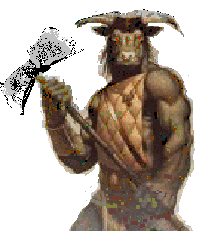
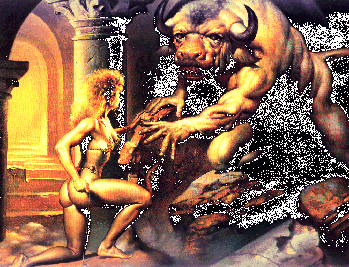
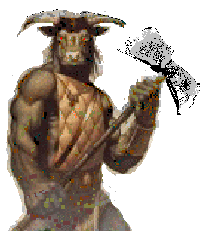
|
A man-eating monster with the head of a bull and the body of a man. The offspring of Pasiphae, queen of Crete, and a snow-white bull King Minos of Crete sacrifed an other bull in place of his favorite snow white bull, to fool Poseidon. This made Poseidon angry. He cast a spell have the kings wife (Pasiphae, queen of Crete) fall in love with that bull. She got Daedalus to help her consummate this passion. By building an ingenious hollow wooden cow, covered with hide and with a door on top through which Pasiphane could lower herself inside. They wheeled it into the pasture where the bull was kept; Daedalus helped her get in, and then discreetly withdrew. Pasiphane was completely satisfied, but to everyone's horror, she then bore the Minotaur, a creature with a man's body but a bull's head. |
|
|
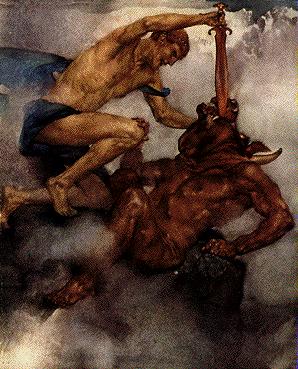 THESEUS was the son of AEgeus,king of Athens, and AEthra, daughter of the king of Troezen. He had several heroic adventures against impossible odds already The Athenians were
dismayed |
Theseus resolved
stop this tribute or die trying. When the time came, youths and maidens (drawn by lot) to be sent as tribute, he offered himself, in spite of his fathers wishes. The ship left under
black sails. Theseus promised his Arriving in Crete,
the youths and maidens were shown to She furnished him
with a sword, with which to encounter the He slew the
Minotaur, escaped from the labyrinth, and took On approaching the
coast of Attica, Theseus forgot the |

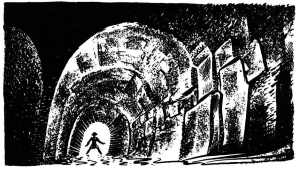 |
|
THE MINOTAURHalf bull, half man, the Minotaur was the most fearsome monster of ancient times. Its horns were sharp as knives, its great hooves could kick the life out the strongest of heroes, and its food was human flesh. The Minotaur lived in the labyrinth, a great maze of winding passages on the island of Crete. Each year seven youths and seven maidens were sent from Greece as food for the beast.One year, Theseus, the greatest of the Greek heroes, said he would go to Crete and fight the monster. "Let me go as one of the victims," he said to his father Aegeus. "I'll kill the Minotaur and free Greece from this peril." Aegeus was unsure. He remembered how others had promised to slay the beast and had ended up dead. But Theseus insisted. Soon his ship was rigged with black sails, which was the custom when Greeks were sailing to meet their doom. "Watch out when I return," said Theseus. "I will hoist white sails to show that I've succeeded." Theseus' ship arrived at the harbour of Knossos, near the palace of King Minos of Crete. The king's daughter, Ariadne, saw the ship. Soon the Greek hero and the beautiful Cretan girl were talking, and, before they knew it, the pair were in love. When Theseus told Ariadne that he was going to kill the Minotaur, she decided she would help him. She knew that even a hero would get lost in the winding passages of the labyrinth. So she gave him a ball of thread. "Unwind it as you go in, then you will be able to find your way out again by following the thread," she explained. So Theseus entered the dark, winding labyrinth, undoing the thread as he went. Soon he heard the bellowing beast, and as he walked on, the roars got louder and louder, until Theseus was at the centre of the maze and face to face with the monster. Now the hero could see the glint in the beast's eyes. He could hear the rumble of its breathing. He could even feel the warmth of his breath as the creature crouched in its lair. Theseus paused, waiting for the best moment to attack. As the creature turned his back, Theseus sprang, plunging his sword into the beast's flesh. The Minotaur gave out one last bellow, and breathed its last. Theseus found his way out of the maze using Ariadne's thread and sailed quickly back to Greece to tell his father that he had succeeded. But Theseus was so excited that he forgot to hoist his white sails. When Aegeus saw his son's ship rigged with the black sails he feared the worst. The old man, despairing, flung himself from the cliff into the seas, and perished beneath the waves. Theseus had won his victory but lost his father, and was sad at heart for many a long year. |
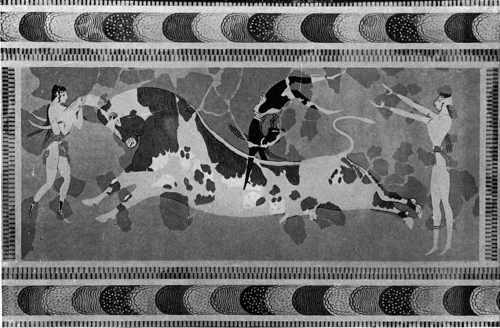 |
|
| When the archaeologists uncovered the ruins at Knossos, they found this strange picture of young men jumping over a bull. Perhaps this was the origin of the myth of the Minotaur. |
LABYRINTHIn the Weird Beast section - we've got the story of the Minotaur. The monster lived in a labyrinth. So we thought that this month we would show you how to make your own labyrinth or maze. |
||
How to draw a labyrinthIt's quite easy to draw a simple labyrinth that has one path from the entrance to the centre. Start by drawing a cross and four dots as shown here. You don't need to write in the numbers. |
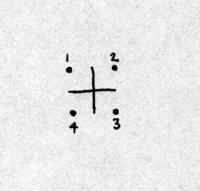 |
|
| Next join the top of the cross to dot 2.
Draw a curving
line from dot 1 to the right-hand arm of the cross. |
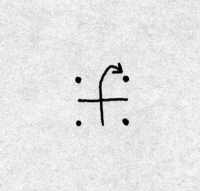 |
|
| Now join the left-hand arm of the cross to
dot 3 with a
long, curving line. |
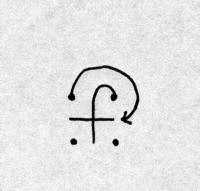 |
|
| Finally, draw an even longer curving line to
link dot 4
with the lower arm of the cross. |
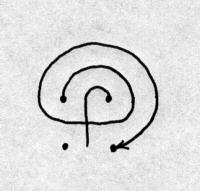 |
|
| Your labyrinth is complete. You can draw bigger labyrinths by starting with a more complicated layout like this. Can you work out how to join the dots and lines? | 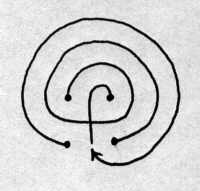 |
|
This is a fairly long story, and I have
broken it
down into sections so that you may select whatever interests you.
I have added the heading "The Story" to distinguish the
currently completed section from soon-to-be-written sections on
the meaning of the myth and the historical background.
THE STORY
This unwise decision annoyed Poseidon, who
avenged the insult by causing queen Pasiphaë to fall madly in love
with the white bull. Her request to Daedalus was that he should help
her consummate this passion. He did so by building an ingenious hollow
wooden cow, covered with hide and with a door on top through which she
could lower herself inside. Together, they wheeled it into the pasture
where the bull was kept; Daedalus helped her get in, and then
discreetly withdrew. Pasiphaë was completely satisfied, but to
everyone's horror, she then bore the Minotaur, a creature with a man's
body but a bull's head. Minos, annoyed in turn, sent to the oracle at
Delphi to discover how he could hide this evidence of the shame to the
royal family. The oracle answered that he ought to have Daedalus build
a suitable cage; Minos thereupon had Daedalus build the Labyrinth, an
enormous maze, and placed the Minotaur at the center of it. Minos also
arranged to sacrifice young men and women to the flesh-eating Minotaur
by shutting them into the Labyrinth, where they would wander,
hopelessly lost, until the Minotaur caught and devoured them. One of Minos's (fully human) sons by
Pasiphaë was Androgeus, who visited Athens to compete in the
All-Athenian games, where he won every contest. King Aegeus knew that
Androgeus was in contact with his internal enemies, the sons of Pallas,
and was afraid that he might persuade his father, Minos, to intervene
on their behalf. Therefore, he laid an ambush for the young man with
the help of the Megareans. After a fierce battle, in which he fought
very bravely, Androgeus was killed. When Minos heard of the death of his son, he became enraged, and gathered a great fleet together to avenge the murder. Although he was the effective ruler of the Mediterranean, quite a few of the Greeks fought on the side of Athens, or stayed neutral. The refusal of Aeacus, the king of Aegina, to join the Cretans was particularly galling to Minos. With all of his power, though, Minos was unable to defeat the Greeks until, in exasperation, he called on the aid of Zeus to avenge Androgeus. Greece was hit by famine and earthquakes, and the oracle at Delphi advised the Athenians to satisfy any demands that Minos made in return for peace. The demand was for a tribute of seven youths and seven maidens to be given every nine years, as sacrifice to the Minotaur, to which the Athenians reluctantly agreed.
In the morning, when Aegeus awoke next to her, he
told her that, if a son were born to her, she should raise him without
divulging his paternity, in case the sons of Pallas should attempt to
murder the boy as a blow to the royal house of Athens. When a son was
duly born, Aethra named him Theseus and, although she was uncertain of
his exact paternity, she raised him as she had been instructed. When he was old enough, she took him to a large
rock, to see if he could lift it. He was able to do so, and underneath
it he found a sword and a pair of sandals left there for him by Aegeus.
He took these items, and set off for Athens. He decided to take the overland route, which was
infested with bandits, rather than the safer sea passage, to prove
himself. On the way, not too surprisingly, he met with many adventures,
and had a suitable number of close calls. When he arrived, he was
nearly poisoned by Medea, who had taken refuge with Aegeus after her
various crimes in Corinth. She had had a son by Aegeus, and when she
recognized who Theseus was, she convinced Aegeus to offer him a cup of
wine laced with wolfsbane. He was just about to drink it when Aegeus
noticed the sword that he carried, and intervened. There was great rejoicing in Athens, but Medea had to flee for her life, and Pallas and his sons were not happy. They began a rebellion, but were crushed by Aegeus's forces under the command of Theseus.
As Theseus emerged from the water, Minos's daughter, Ariadne, who had accompanied her father to see the arrival of the ship, fell instantly in love with him. She determined to help him, and enlisted the aid of the ubiquitous Daedalus, who came up with the idea of using a ball of string to trace the way into, and back out of, the Minotaur's lair.
As they made their way north towards Athens, they
stopped at the island of Naxos. There, for reasons that remain obscure,
Theseus left Ariadne behind - an act that is hard to describe as
creditable to his reputation. She later became the bride of Dionysus,
and bore him many children, but at first she was in a poor mood, and
cursed Theseus. The curse was almost instantly fulfilled, for Theseus forgot to change his sail from black to white. As the ship pulled in to port, Aegeus, seeing the black sail, assumed the worst, and lept from a precipice to his death in the sea that still bears his name.
Daedalus continued on, making his way eventually
to Camicus in Sicily, where he was welcomed by king Cocalus. Meantime,
Minos determined to retrieve his master craftsman, and raised a fleet
to find him. He needed to discover the whereabouts of the artisan, and
he did so by proclaiming a huge prize everywhere he went for anyone who
could draw a linen thread through the convolutions of a triton shell.
Once the fleet was in Sicily, and he heard of the prize, Daedalus could
not resist winning it. He did so by fastening a gossamer thread to an
ant, and entering it into the shell through a hole that he had bored in
the end, meantime smearing the open end of the shell with honey so that
the ant would weave its way through to the source of the scent. He then
tied the linen thread to the gossamer, and drew it through in turn. As soon as Minos knew that the the prize had been
claimed, he knew where Daedalus was, and he made war on the Sicilians,
defeating them. While he bathed in the palace at Camicus, though, the
daughters of Cocalus, with the help of Daedalus, killed him by pouring
boiling water on him through a cleverly fashioned vent above the tub.
He joined his brother Rhadamanthys and his old enemy Aeacus in Hades,
where they were made judges of the dead. Daedalus eventually moved on,
and ended his days in Sardinia.
|
|
A production of Minotaur Websites |
The story of Theseus and the Minotaur is well known. The following story is true to the myth, but is from Thesues' point of view.
by Daniel Rattner
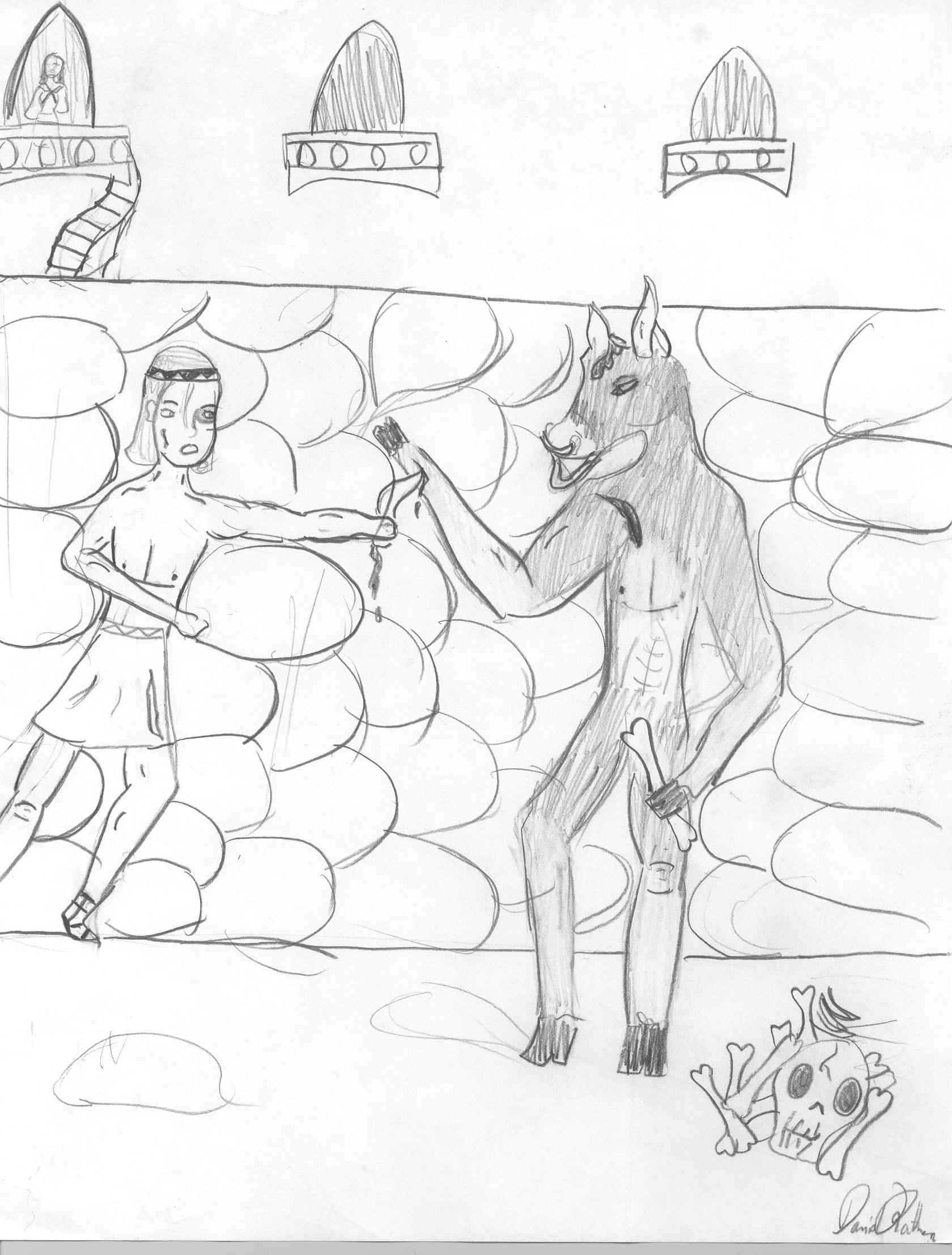 The Minotaur was a half-man half-bull monster owned by King Minos.
Twice a year people had to pay a tribute to feed the monster.
The Minotaur was a half-man half-bull monster owned by King Minos.
Twice a year people had to pay a tribute to feed the monster.
I stood on the stone balcony over looking the sea. I sighed and looked
out at the water in front of him. I am at my father’s palace tomorrow I
will venture to Crete. “You don’t have to do this son” said my father
the king stepping out on to the balcony. “I know father but I must, I
must liberate our city from this terrible tribute” I replied and walked
inside and got into bed. Poseidon please give my son safe passage to
Crete, the king prayed silently gripping the railing.
The next morning I boarded the ship. My father came to say goodbye and
he told his son that if he returned successfully to raise a white sail.
A tear stung at my eye but I didn’t cry. I was a day away from Crete,
the other victims and me stared out at the water and the blank sky. I
wondered what was to become of what was my fate? All of a sudden an
island loomed in front of us, and a giant palace topped the land.
Towers rose up to the sky with floors, piled on floors and scattered
balconies and terraces. Scores of pillars shaped like bull horns held
up the roofs. In the center was a courtyard and there were gardens and
fields galore. Surrounding the beautiful palace were tiny houses with
men working in the fields growing wheat and fruits. The graceful ship
docked at the island as Eos was touching the sky with her rosy
fingertips.
We entered the palace and were led to a room were a king sat on the
throne he was no other than King Minos. So this is the terrible king I
thought, I gritted my teeth and stared at the man. At his side were his
beautiful daughters Ariadne and Phaedra. “So these are the little
victims?” growled King Minos. “I am Theseus of Athens and I will kill
the Minotaur!” I said my anger boiling up inside me. Ariadne turned to
look at the owner of the voice and she saw a dark skinned strong and
handsome young man and she fell in love with him. “You will go first
brat!” King Mines spat at me.
That night I slept in the jail; I kept on waking up as I could not
sleep. Just then a figure slid to my cell window. “I will help you
Theseus of Athens.” The girl removed her hood and revealed herself. She
was beautiful but then I realized that I had seen that face before.
“You’re –“ I started. “Shhh!” she cautioned. “I am Ariadne, daughter of
King Minos. Tomorrow you enter the labyrinth I will be there waiting
for you.” And without another word she slipped away.
The next day I was awakened when two guards grabbed me and pulled me
into the palace. We went down flights of stairs going through corridors
and passageways until finally we reached a flight of stairs. The guards
pushed me forward and then left. From the shadows out slipped Ariadne.
“Theseus, Daedalus has given me this; it will help you find your way
back I will hold on to one end and put the ball of thread in front of
you, it will lead you to the Minotaur.” “Thank you.” I said gratefully
and crept down the stairs following the ball of thread.
I went down and down, pools of water were scattered along the paths and
bits of rock hung over me. I got down to an area that was completely
grassy. As I pushed my way through the tall grass I stumbled upon the
lair of the Minotaur. The hideous beast was sleeping. Mustering all my
strength I yelled and charged at the monster. He woke and saw me
charging him. I leapt on him stunning him and ripped a horn from his
head. The brute slashed at my chest and threw me, I landed on the
ground. Dazed I lay there. The half-bull half-man creature leapt up and
was ready to finish me off. I rolled over and the monster smashed into
the ground. I jumped on him and taking the horn I stabbed into his
back. The monster hit me in the face. Blood was poring from my forehead
and nose and there were deep scratches along my body. Blood poured from
the Minotaur’s back. I jumped off him as he managed to stand and flew
at him strangling him to death with my bare hands. Blood was pouring
all over me. I don’t know how but I managed to escape the labyrinth
where I fell into Ariadne’s arms. We escaped, taking the rest of the
prisoners with us. We destroyed the evil King’s boats so they could not
catch us.
Meanwhile at the palace King Minos had learned of the Minotaur’s death
and was furious. “Get the prisoners!” “They’ve escaped sire!” informed
a guard. Minos cursed under his breath and screamed, “Well follow
them!” The boats could not sail and King Minos stood on the beach
defeated.
I was extremely happy, I had a new bride, I had freed my city from the
awful tribute, defeated Minos and was to become king. That night I
slept out on the deck. In my dream Dionysus stood there. “You must
leave Ariadne I have chosen her!” he demanded. In the morning when I
woke up I remembered the dream. When I reached the island Naxos Ariadne
was still sleeping. I set the sleeping Ariadne down on the island and
sailed away, tears stinging at my eyes. In my grief I forgot to raise
the white sail and my father jumped from the cliffs killing himself. I
became a sad and lonely ruler. The two people dearest to me were gone,
but I have always kept the ball of thread that was given to me by
Ariadne.
THE END



| |
| John Watson Davis (1870-1959) Theseus and the Minotaur |
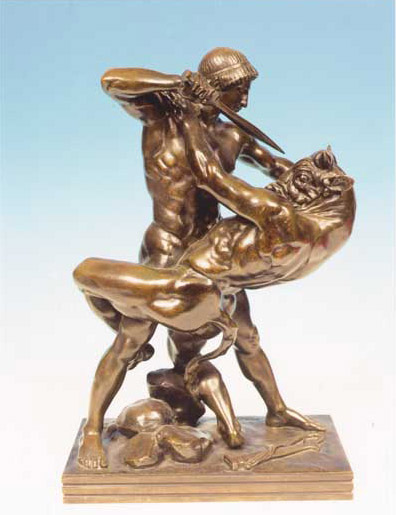
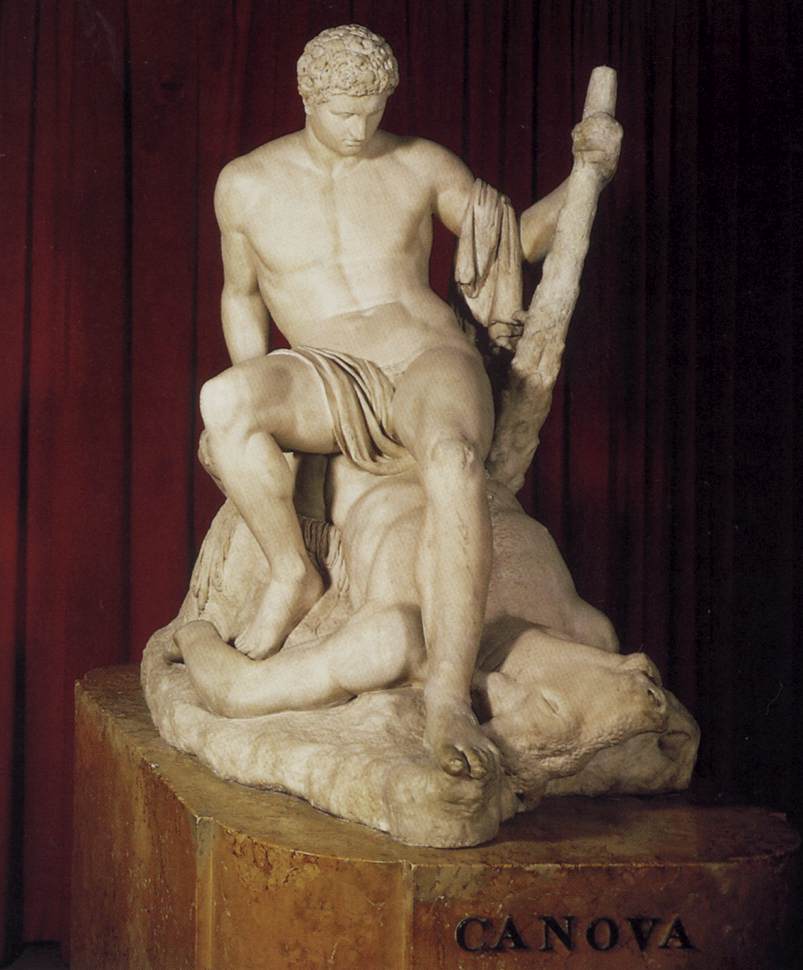
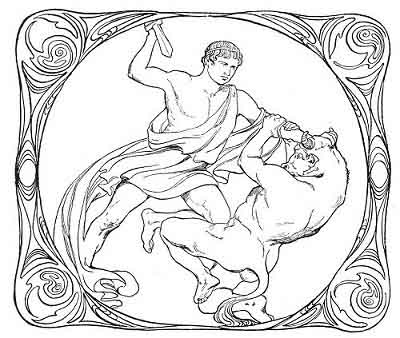


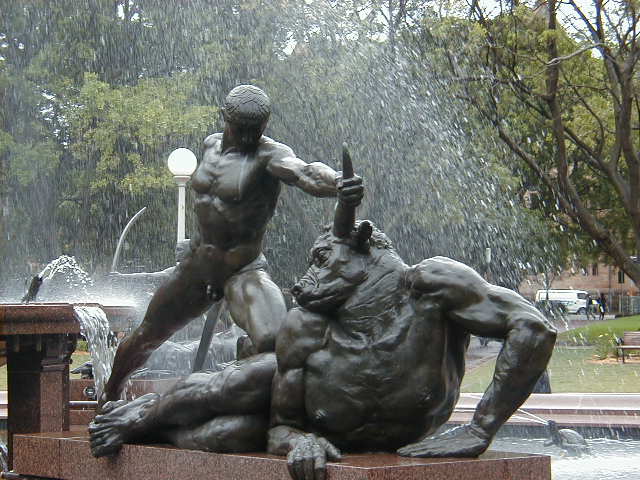



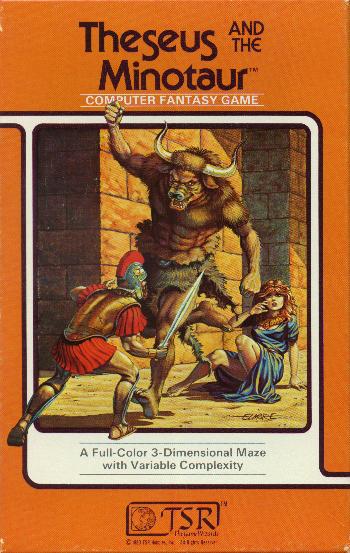


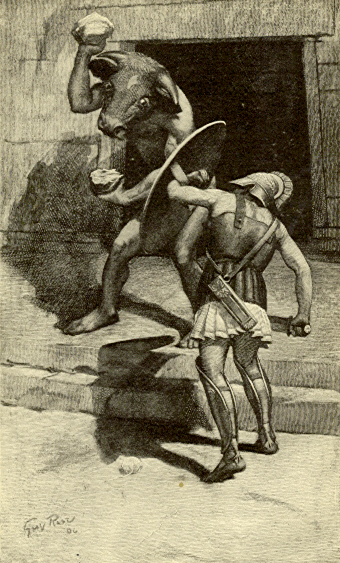
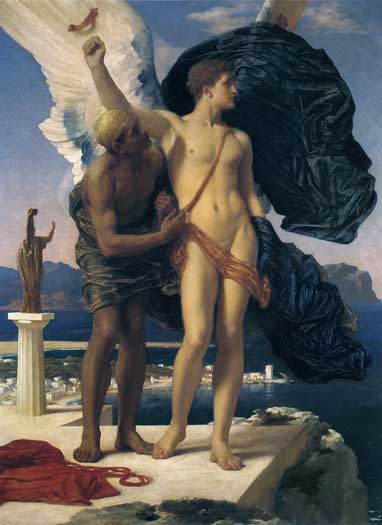 |
|

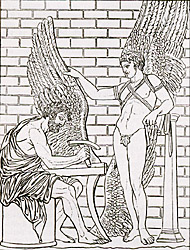
Vergil places the inventor-craftsman Daedalus in Cumae, where
legend said he arrived after escaping from King Minos, ruler of Crete,
on wings he built for himself and his son Icarus, who tragically
plunged to his death when the sun melted the wax of his wings. In
thanksgiving for his own safe arrival, he built a Temple to Apollo, on
the doors of which he carved scenes from the lurid story of Pasiphae,
her lust for the bull which produced the Minotaur, the Labyrinth,
Ariadne's rescue of Theseus, and his own involvement, which cost his
son his life
-------------------------------------------
 |
The Story of
Daedalus and Icarus from The Metamorphoses, Book 8 Translated by Rolphe Humphries |
| Homesick for homeland, Daedalus hated Crete | |
| And his long exile there, but the sea held him. | |
| "Though Minos blocks escape by land or water," | |
| Daedalus said, "surely the sky is open, | |
| 5 | And that's the way we'll go. Minos' dominion |
| Does not include the air." He turned his thinking | |
| Toward unknown arts, changing the laws of nature. | |
| He laid out feathers in order, first the smallest, | |
| A little larger next to it, and so continued, | |
| 10 | The way that panpipes rise in gradual sequence. |
| He fastened them with twine and wax, at middle, | |
| At bottom, so, and bent them, gently curving, | |
| So that they looked like wings of birds, most surely. | |
| And Icarus, his son, stood by and watched him, | |
| 15 | Not knowing he was dealing with his downfall, |
| Stood by and watched and raised his shiny face | |
| To let a feather, light as down, fall on it, | |
| Or stuck his thumb in the yellow wax, | |
| Fooling around, the way a boy will, always, | |
| 20 | Whenever a father tries to get some work done. |
| Still, it was done at last, and the father hovered, | |
| Poised, in the moving air, and taught his son: | |
| "I warn you, Icarus, fly a middle course: | |
| Don't go too low, or water will weigh the wings down; | |
| 25 | Don't go too high, or the sun's fire will burn them. |
| Keep to the middle way. And one more thing, | |
| No fancy steering by star or constellation, | |
| Follow my lead!" That was the flying lesson. | |
| And now to fit the wings to the boy's shoulders. | |
| 30 | Between the work and warning the father found |
| His cheeks were wet with tears, and his hands trembled. | |
| He kissed his son (Good-bye, if he had known it), | |
| Rose on his wings, flew on ahead, as fearful | |
| As any bird launching the little nestlings | |
| 35 | Out of high nest into thin air. Keep on, |
| Keep on, he signals, follow me! He guides him | |
| In flight--O fatal art!-- and the wings move | |
| And the father looks back to see the son's wings moving. | |
| Far off, far down, some fisherman is watching | |
| 40 | As the rod dips and trembles over the water, |
| Some shepherd rests his weight upon his crook,, | |
| Some plowman on the handles of the plowshare, | |
| And all look up, in absolute amazement, | |
| At those airborne above. They must be gods! | |
| 45 | They were over Samos, Juno's sacred island, |
| Delos and Paros toward the left, Lebinthus | |
| Visible to the right, and another island, | |
| Calymne, rich in honey. And the boy | |
| Thought This is wonderful! And left his father, | |
| 50 | Soared higher, higher, drawn to the vast heaven, |
| Nearer the sun, and the wax that held the wings | |
| Melted in that fierce heat, and the bare arms | |
| Beat up and down in air, and lacking oarage | |
| Took hold of nothing. Father! he cried, and Father! | |
| 55 | Until the blue sea hushed him, the dark water |
| Men call the Icarian now. And Daedalus, | |
| Father no more, called "Icarus, where are you! | |
| Where are you Icarus? Tell me where to find you!" | |
| And saw the wings on the waves and cursed his talents, | |
| 60 | Buried the body in a tomb, and the land |
| Was named for Icarus. |

Theseus - The Musical was conceived, written and produced by Dauntsey's teachers Tim Price and Jon Hunt, and was performed by members of the Lower School in June and July 2000. On four successive nights the eighteen-song-strong original score took audiences on a one-and-a-half-hour whirlwind tour of the Ancient Greek world, from Delphi to Athens to Crete and back again.

Daedalus was famous for being a sculptor, architect and inventor. Unfortunately, he made the king mad one day. He and his son Icarus were locked up in a tall tower. Daedalus used candle wax and feathers from birds to make a pair of wings. He was able to fly around inside his cell.


Daedalus made another set of wings for Icarus. They were going to escape from the tower. He warned Icarus to fly high enough to avoid the dampness of the sea. However, if he flew too high, the sun would melt the wax in the wings. They flew out the window to freedom.



Icarus was having so much fun flying that he forgot his father's warning. He flew too close to the sun and his wings melted. He plunged into the sea and died. Daedalus looked for him but could only find a handful of feathers.
In this story, someone is able to fly using an invention, not the powers of a god or spirit.
--------------------------------------------------------Minos had to have the labyrinth to imprison his wife's son with a white bull, the Minotaur. Daedalus had built Minos' wife, Pasiphae, a wooden cow so she could mate with the bull. Poseidon had cursed her with bestiality.
When at last the work was done, the artist, waving his wings, found himself buoyed upward and hung suspended, poising himself on the beaten air. He next equipped his son in the same manner, and taught him how to fly, as a bird tempts her young ones from the lofty nest into the air. When all was prepared for flight, he said, "Icarus, my son, I charge you to keep at a moderate height, for if you fly too low the damp will clog your wings, and if too high the heat will melt them. Keep near me and you will be safe." While he gave him these instructions and fitted the wings to his shoulders, the face of the father was wet with tears, and his hands trembled. He kissed the boy, not knowing that it was for the last time. Then rising on his wings he flew off, encouraging him to follow, and looked back from his own flight to see how his son managed his wings. As they flew the ploughman stopped his work to gaze, and the shepherd learned on his staff and watched them, astonished at the sight, and thinking they were gods who could thus cleave the air.
Daedalus could not leave the island by sea, as the king kept strict watch on all the vessels, and permitted none to sail without being carefully searched. Since Minos controlled the land and sea routes, Daedalus set to work to fabricate wings for himself and his young son Icarus. He wrought feathers together beginning with the smallest and adding larger, so as to form an increasing surface. The larger ones he secured with thread and the smaller with wax, and gave the whole a gentle curvature like the wings of a bird. When at last the work was done, the artist, waving his wings, found himself buoyed upward and hung suspended, poising himself on the beaten air. He next equipped his son in the same manner, and taught him how to fly. When both were prepared for flight, Daedalus warned Icarus not to fly too high, because the heat of the sun would melt the wax, nor too low because the dampness of the sea would clog the wings. Then the father and son flew away.

They had passed Samos, Delos and Lebynthos when the boy began to soar upward as if to reach heaven. The blazing sun softened the wax which held the feathers together, and they came off. Icarus fell into the sea. His father cried and bitterly lamenting his own arts, he buried the body and called the land Icaria in memory of his child. Daedalus arrived safe in Sicily in the care of King Cocalus, where he built a temple to Apollo, and hung up his wings, an offering to the god.
Daedalus was so proud of his achievements that he could not bear the idea of a rival. His sister had placed her son Perdix under his charge to be taught the mechanical arts. He was an apt scholar and gave striking evidences of ingenuity. Walking on the seashore he picked up the spine of a fish. Imitating it, he took a piece of iron and notched it on the edge, and thus invented the saw. He put two pieces of iron together, connecting them at one end with a rivet, and sharpening the other ends, and made a pair of compasses. Daedalus was so envious of his nephew's performances that he took an opportunity, when they were together one day on the top of a high tower, to push him off. But Athena, who favors ingenuity, saw him falling, and arrested his fate by changing him into a bird called after his name, the partridge. This bird does not build his nest in the trees, nor take lofty flights, but nestles in the hedges, and mindful of his fall, avoids high places. For this crime, Daedalus was tried and banished.
Daedalus other son was Iapyx. Iapyx was Aeneas '
healer during the Trojan War. He escaped to Italy after the war and
founded Apulia.
------------------------------------------

---------------------------------

------------------------------------------------
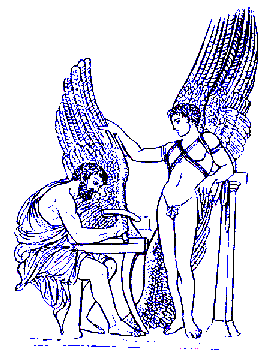
Minos called on Daedalus to build the famous Labyrinth in order to imprison the dreaded Minotaur. The Minotaur was a monster with the head of a bull and the body of a man. He was the son of Pasiphae, the wife of Minos, and a bull that Poseidon had sent to Minos as a gift. Minos was shamed by the birth of this horrible creature and resolved to imprison the Minotaur in the Labyrinth where it fed on humans, which were taken as "tribute" by Minos and sacrificed to the Minotaur in memory of his fallen son Androgenos.
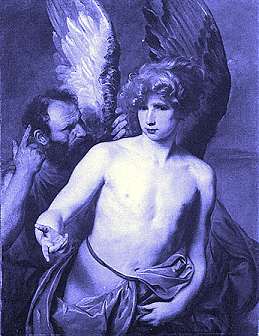 Theseus,
the heroic King of Athens, volunteered himself to be sent to the
Minotaur in the hopes of killing the beast and ending the "human
tribute" that his city was forced to pay Minos. When Theseus arrived to
Crete, Ariadne, Minos's daughter, fell in love with him and wished to
help him survive the Minotaur. Daedalus revealed the mystery of the
Labyrinth to Ariadne who in turn advised Theseus, thus enabling him to
slay the Minotaur and escape from the Labyrinth. When Minos found out
what Daedalus had done he was so enraged that he imprisoned Daedalus
& Icarus in the Labyrinth themselves.
Theseus,
the heroic King of Athens, volunteered himself to be sent to the
Minotaur in the hopes of killing the beast and ending the "human
tribute" that his city was forced to pay Minos. When Theseus arrived to
Crete, Ariadne, Minos's daughter, fell in love with him and wished to
help him survive the Minotaur. Daedalus revealed the mystery of the
Labyrinth to Ariadne who in turn advised Theseus, thus enabling him to
slay the Minotaur and escape from the Labyrinth. When Minos found out
what Daedalus had done he was so enraged that he imprisoned Daedalus
& Icarus in the Labyrinth themselves.



